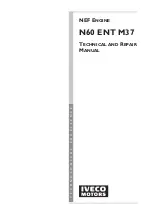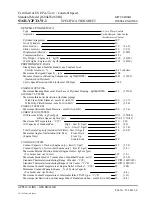
Please note, that your engine requires around 2 hours of running in. During this time, your engine will not
be performing at its optimum, vibration may be higher and there may be increased oil leaking. For this rea-
son always run in the engine on a test stand
Once the engine starts for the first time, leave the glow supply connected
and let the engine warm up at a
fast idle speed for 30 or so seconds. Increase the throttle setting to about ¼, and tune the high-speed nee-
dle valve for slightly rich running i.e. a slightly burbling exhaust note (if you have a tachometer aim for
around 3000 rpm). The glow supply can now be disconnected although some drop in RPM may occur due
to the rich mixture and comparatively low engine temperature. Leave the engine running like this for around
15 minutes. Stop it using the throttle and allow it to cool for a further 15 minutes. Now you can obtain the
correct carburettor setting using the following procedure:
a) Restart the engine, open the throttle wide and adjust the main needle for just slightly rich (a few
rpm short of peak).
b) Close the throttle to around 1/3
rd
and, with the engine at around 3000 rpm, screw in the secon-
dary needle until the rough (rich) running smoothes out into a nice four-stroke note. The needles
are now ROUGHLY set but you will probably have to richen the main needle on the throttle up to
full power. Test and adjust before returning to 3000 rpm.
c) Reliable, slow running will not be achieved until the engine has been run in for at least one hour.
When this running time has elapsed you can fine tune the idle needle. NB. Close attention to the
idle needle settings will pay dividends in smoothness
CARBURETTOR ADJUSTMENT
Main Needle Adjustment (high speed):
The main needle should be adjusted with the engine operating at
full throttle. The engine should be leaned out until the RPM peaks, then enriched a small amount. This will
allow for the leaning out that normally occurs in flight. If the engine is installed in a model, the nose of the
model should be raised to the vertical to check that the engine will run without leaning out in this attitude.
Note that to lean the engine out the needle is screwed in. If you wish to get back to the original factory nee-
dle settings, screw the needle in fully and then unscrew 1 3/4 turns (this is only a starting point as there is
no hard fast rule).
Idle needle adjustment (low speed):
If the engine does not run cleanly at low or mid throttles the usual
problem is that the idle needle is incorrectly set. Please follow the following guidelines to decide how the
idle needle should be adjusted. If you wish to get back to the original factory needle settings, screw the
needle in fully and then unscrew 4 turns with the throttle closed (this is only a starting point as there is no
hard fast rule).
Idle needle fault finder
Idle mixture too lean:
There will be a tendency for the engine not to start at low throttle settings. Once
it does start it will run cleanly at mid throttle but will tend to die at low throttle. It will also tend to die
when the throttle is opened rapidly. In general there will be little or no increase in engine speed when
the glow plug is energised.
Idle mixture too rich:
The engine will start readily. It will run roughly at mid throttle settings, and at idle
will splutter and pop. When glow is energised the engine will run more cleanly and the idle will speed up
considerably.
Idle mixture correctly set:
The engine will start readily and run cleanly from idle to max RPM. The idle
will sound slightly rich and “poppy”. Idle speed will increase slightly when the glow is energised. The
throttle can be opened rapidly without the engine stalling.
NB.
The idle mixture is sensitive, therefore increments of 1/8
th
of a turn or less are all that is normally
required.
NORMAL RUNNING
Once your needles have been adjusted correctly, they will not need to be changed unless different fuel or
propellers are used, or if the temperature changes significantly.
Once your engine has been fully run in you should expect the
following performance (this is a guideline only):
RCV recommend keeping the rpms below 5500
Propeller
Idle
Max. RPM
18 x 12 (2B)
1400
5500
15.75x13 (3B)
1400
5300
15.5x12 (4B)
1400
5400
SECTION 5 RUNNING IN
Issue 2 01/06/2004 © RCV Engines Ltd
Page 4
This engine is subject to Global Patents and Design copyrights
SECTION 6 INSTALLING THE ENGINE IN A MODEL
The RCV SP series produces a similar amount of power to a conventional 4 stroke. Just use the 4-stroke
engine size as recommended by your model kit manufacturer.
The 2:1 gearing on the prop means that the torque reaction forces are double that normally expected from
a conventional four stroke. The most noticeable effect of the 2:1 gearing on the operation of a model is
that the torque pulses transmitted back to the airframe are double that normally expected, this means the
tortional oscillations applied to the airframe are greater. This in itself does not cause any problems, but it
does mean that the construction of the fuselage around the engine mount, and between the engine mount
and the wings, must be very rigid.
Try to avoid large hatches in the fuselage in this region, ensure all materials used are of suitable quality
and always run the model with the wings firmly attached. Ensure the engine is mounted according to the
instructions.
An RCV engine is convenient to mount in a model, however it does need to be mounted securely. It
would normally be radially mounted on the same bulkhead that would take the nylon engine bearers for a
conventional engine. The engine should not be attached to this bulkhead with screws or self-tappers. The
recommended method is use a metal plate (supplied with engine). See information below on fitting the
backplate
o
The larger than normal tortional forces from the geared prop mean that the engine must be very
securely mounted.
o
The fuel tank should be installed with its centre line as near as possible to the centre line of the
carburettor.
o
The carburettor may be rotated by 180 º to aid mounting.
o
The crankcase breather is the same as on a conventional four stroke. It cannot be used for fuel
pressurisation and should simply be vented to atmosphere.
o
You may however use some fuel tube on the crankcase breather to re-direct any excess oil outside of
the cowl, or to a collection point.
o
The use of conventional rubber engine mounts are not recommended. When using such mounts, the
tortional movement of the engine is excessive.
o
One of the advantages of the RCV design is that the top half of the engine can be reassembled to the
bottom half of the engine in one of four rotational positions. (
See Dismantling Section
).
RCV ENGINE MOUNTING BACKPLATE
•
The RCV Engine Mounting Backplate is intended to ensure the RCV can be firmly and conveniently
bolted to the firewall of any model aeroplane (or test stand). It is mounted on the opposite side of the
firewall to the engine. The firewall is thus effectively sandwiched between the engine and the back-
plate. This ensures that the engine cannot run loose.
•
The firewall should first be measured up and drilled to accept the four M4 engine mounting bolts in the
normal manner. The Backplate should then be lined up with the four mounting holes on the inboard
side of the firewall and attached using two small self tapping screws through the two 3mm holes.
These will hold the backplate in place when the engine is not attached.
•
The engine can now be conveniently mounted onto the model at any time using the M4 cap head
screws supplied. A spring and plain washer should be included between the head of the screw and
the engine mounting lugs.
Important Installation Information
Issue 2 01/06/2004 © RCV Engines Ltd
Page 5
This engine is subject to Global Patents and Design copyrights






















